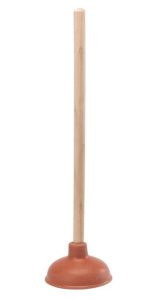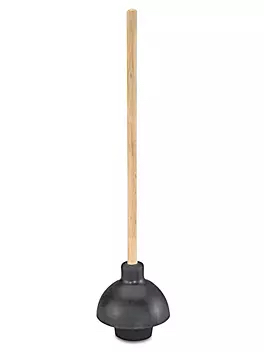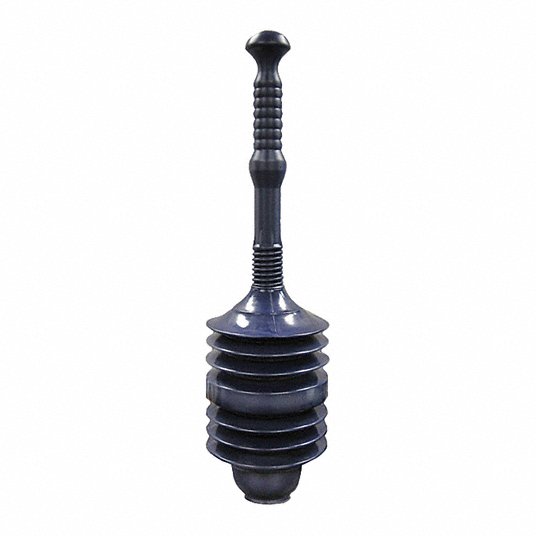A plunger is a common handheld plumbing tool in any household, yet its correct use can sometimes be overlooked. Mastering the plunging technique is crucial, and that’s why, in this post, we’ll show you the correct instructions for using a plunger to unclog toilet or sink drains successfully. We’ll also guide you through different types of plungers for specific needs and give you tips on maintaining them for better hygiene.
What are the different types of plungers and their use?
Plungers come in three different types, and you can use each for different clogs:
Cup Plunger

The cup plunger is a standard plunger with a rubber bottom and a wooden handle. It works great on sink clogs because its design suits flat surfaces. Simply lay the cup flat over the sink drain and plunge the handle up and down several times to create the vacuum needed to unclog it.
Sometimes, plumbing supply stores and plumbers call the cup plunger a “force cup plunger,” usually because of the extra force it deploys to the clogged sink drains.
Flange Plunger

A flange plunger looks like a cup plunger, but its bottom has an additional flap, i.e., a flange, that folds out from inside the cup’s base. This flange fits really well over all sorts of toilet drains and creates the necessary vacuum for suction to clear the clog.
Accordion Plunger

The third type is the accordion plunger, which is made from hard plastic and suitable for dislodging the toughest toilet clogs. The downside of this plunger is that you may need to put in a lot of effort to create an effective seal, and it often leaves a scratch on the porcelain or old toilet bowl.
What is the Correct Way to Use a Plunger?
Plunging may seem straightforward, but there’s a finesse to it that ensures success without creating a mess. First, choose a plunger specifically designed for sink or toilet use, and then follow the step-by-step instructions below:
- Put on a pair of rubber gloves and lay a few towels or rags on the toilet floor to prevent any mess from overflowing while plunging.
- Make sure the standing water in the toilet bowl is high enough to cover the whole plunger cup.
- Place the plunger’s cup into the bottom of the toilet bowl, tilt it to fill it with water, and insert it fully into the waste inlet.
- Gently pump the plunger a few times to let air out of the cup and ensure a good seal.
- When you hear water pounding back and forth, push and pull the plunger up and down with force for 15-20 seconds.
- Check and if the water is still slow to drain or remains backed up, add more water in the bowl and repeat the above process until the clog clears.
Plungers may not work on the toughest of obstructions and can worsen the problem.
How to Keep a Plunger Sanitary?
After unclogging your toilet drain, maintaining a plunge ensures it remains effective and hygienic for future use:
- Rinse: After using the plunger, flush the toilet to rinse it off.
- Disinfect: Fill a bucket with hot water and add a disinfectant or bleach solution. Submerge the plunger cup in the water for about 10-15 minutes, then remove it.
- Scrub: If any residue remains, use a toilet brush or an old toothbrush to scrub the cup, and rinse again with hot water.
- Dry: With a few jerks, let the excessive water drip off of the plunger and place it outside to air dry completely.
- Storage: Hang the plunger on a hook or holder in a dry, cool utility cabinet.
Tip: Check your plunger after each use. If you see any cracks, a hardened rubber cup, or wear that comes over time, replace it with a new one.
What are the Dangers of a Clogged Toilet?
A blocked toilet poses a threat to your health because sewage is never supposed to be trapped inside your home plumbing system:
Unpleasant odors and mold: Standing water combined with waste in a blocked toilet becomes a nesting ground for mold. You also breathe in foul odors coming out of sink and toilet drains that spread through your home. Both of these scenarios lead to respiratory issues and make things even worse for people with asthma.
Bacterial infections: A clogged toilet or kitchen drain may contain food particles that lead to bacterial growth. These microorganisms thrive in damp and dark places and sicken anyone with a weak immune system.
Insect invasion: Blocked sinks or toilet drains attract insects like moths, flies, and gnats, which fly around and create a feeling of disgust in your household. This can embarrass you, especially if guests are in your home.
Along with these health issues, you may experience water overflowing onto your bathroom floor from a blocked toilet drain, which results in structural damage and costly repairs.
When Should You Call a Plumber for Toilet Clogs?
A plunger is a handy tool, but it sometimes fails to clear the stubborn clogs. You may need to try alternatives like removing the toilet and clearing it from the waste opening or the base.
Doing this yourself can be ineffective as you may have to go further deep into the waste line of a backed-up toilet, a slow-draining sink, or a clogged shower. So, it’s time to call a professional plumber to eliminate the problem from its root for a long-term fix.
